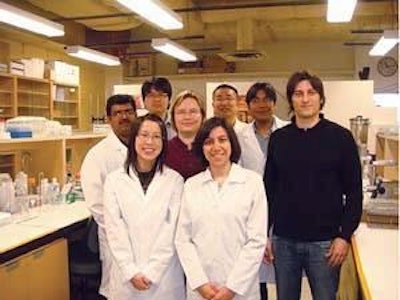
As the poultry industry looks for ways to drive chicken consumption and improve profitability, scientists at the University of Alberta, Canada, are experimenting with new technologies that may help on both fronts.
A research group is investigating several promising approaches that may lead to a variety of new poultry meat products that exhibit enhanced taste and nutritional characteristics and that would justify higher margins.
They are also looking at new technology for protein recovery that would enable producers to recapture some of the nutritional and monetary value that is currently being lost in the production process.
The work is being led by Dr Mirko Betti, assistant professor of poultry meat science at the University of Alberta’s Department of Agricultural, Food and Nutritional Science. Joining him on the protein recovery project is a team of seven graduate students, one post-doctoral student and a technician.
“Today’s consumers look at food differently that in the past,” Professor Betti says. “They are typically more aware of the nutritional aspects of what they eat and, increasingly, take a more active role in determining what foods best serve their health need and overall lifestyle. This trend offers an opportunity for poultry processors.”
Dr Betti is working with the business accelerator TEC Edmononton, which is assessing a commercialization strategy to take the team’s work to market, while funding is coming from the Alberta Livestock Meat Agency, Alberta Chicken Producers, Alberta Turkey Producers and the Poultry Research Centre at the University of Alberta.
The market for poultry products has undergone a sea change over the last three decades. For example, in the US in 1975, whole birds accounted for 61% of sales, cut-up for 32% and “further processed” products for only 7%. According to the National Chicken Council, however, by 2008, these numbers had been almost completely reversed, with further processed poultry products accounting for 48% of the market, cut-up 41% and whole birds only 11%.
Opportunities
Amongst the research areas of Dr Betti’s team are methods to recover protein from mechanically separated poultry meat and spent hens.
The team is developing a new technology that will enable not only the extraction of proteins from these by-products, but also a reduction in the fat content and the removal of heme pigments.
The team’s current work builds on earlier research that Dr Betti carried out in conjunction with Dr Daniel Fletcher at the University of Georgia.
Possible applications of the recaptured proteins include meat fillers, edible protein film (casings), biodegradable packaging, and coating agents.
Initial results from the laboratory work into recovering proteins from “low value” poultry meat were presented at the 2009 Poultry Science Association meeting.
“One additional advantage of using poultry proteins as functional ingredients for food applications is that humans seem to have a lower predisposition to allergenic reactions towards proteins sourced from poultry than they do to other sources of protein, such as fish, soybeans, eggs or milk,” explains Dr Betti.
Higher value
The University is also looking at increasing omega-3 fatty acids in poultry meat.
One primary challenge is that, because white meat is very lean, it is difficult to enrich with omega-3. Dark meat, however, is much easier and faster to enrich: it can be made to have almost the same composition as salmon within 4-6 days through the use of bird flax seeds or other sources of omega-3.
Given the size of the omega-3 food market – approximately US$2 billion in North America alone and forecast to reach US$7 billion within the next three years – there is an enormous opportunity for the poultry industry to offer consumers a more diversified choice of omega-3 rich protein sources beyond those currently recommended, such as salmon, cod and sardines.
Dr Betti is also studying the effects of high-pressure processing (HPP) on chicken meat proteins. HPP is an emerging technology, first developed in Japan in the 1970s and 1980s for pasteurizing fruit juices, and uses hydrostatic pressure rather than heat to sanitize food. It is a way of cooking food without using heat, so that nutrients normally damaged by the heating process are preserved.
One challenge of HPP, however, is that it is expensive. However, Dr Betti believes that producers eventually will be able to justify the additional expense by developing products further up the value-added curve, which ranges from conventional and health foods to clinical and functional foods.
In an era when consumers are increasingly looking for “natural” food, is there a place for the Alberta team’s work?
“Absolutely,” says Dr Betti. “We are learning how to produce processed meat products (i.e. ready-to-eat meat), with new emerging technologies which have the ability to reduce the amount of meat additives.
“The more technology we develop, the more we will be able to produce processed foods that look natural – high pressure processing goes exactly in this direction.
“The fight between natural and artificial does not exist,” he notes, “it has been created based on the error that everything produced by humans is bad. It is exactly the opposite.”

















